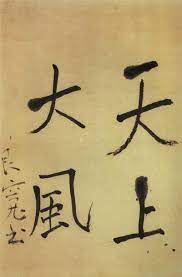
As I was walking up North Main Street in Alfred, New York a few weeks ago, I stopped to look at a row of Cleveland pear trees spanning two front yards. The trees were in full bloom. Their brilliant white blossoms caught the late-morning light.
A week later, those blossoms had fallen. Only the green leaves remained. I was reminded of a haiku by the Zen master, poet, and calligrapher Daigu Ryokan (1758-1831):
Falling blossoms
Blossoms in bloom are also
falling blossoms
As Kazuaki Tanahashi, Ryokan’s biographer and translator, has noted, this haiku “presents the Zen paradox that flourishing is no different from withering.”* Flourishing and withering are two distinct phases in the life cycle of blossoming trees, but the two are one in the stream of life.
If Ryokan’s haiku embodies the paradox of non-duality, it also represents the principle of impermanence, one of the fundamental tenets of the Zen tradition. Ryokan entered a Zen temple at the age of sixteen and was ordained as a monk two years later. Through his rigorous Zen training and his intensive study of Japanese classical poetry, he was well acquainted with the truth of impermanence, a truth harshly confirmed when his father, a prominent and prosperous local official, ran afoul of the ruling shogunate and committed suicide by drowning. Yet, for all his understanding of transiency, Ryokan could still be moved by fresh evidence of that inviolable law. On one occasion, as he was walking down a path at the foot of a mountain, he came upon “an ancient cemetery filled with countless tombstones.” The names on the tombstones were obliterated, the lives of the dead long since forgotten. “Choked with tears, unable to speak,” he took his staff and returned home.
Ryokan lived alone in a thatched-roof mountainside hut, having renounced the world of money, fame, and power. A mendicant monk, he often ventured into a nearby village, where his calm presence was said to confer an atmosphere of peace on the places and people he encountered. From time to time, he invited visitors to his hut for tea or sake, but for more than twenty years, he spent the bulk of his hours in silence and solitude, tending his garden, practicing zazen, and reading and writing poetry, companioned only by the natural world:
Only two in the garden,
plum blossoms at their peak
and an old man full of years
As vivid as it is immediate, this haiku presents one of many such impressions in Ryokan’s poems. Collectively these sensuous impressions register an uncommon intimacy with the sights, sounds, and smells of his natural environment. Whether he is noting a nightingale in the brush, frogs “chanting,” “plum trees reflecting the silver moon,” hail striking bamboo, wind in the pines, or a monkey’s cries from a distant valley, Ryokan’s imagery bespeaks a cultivated openness to what the dharma teacher Gaylon Ferguson has called the “redemptive fullness” of the natural world.* In contrast to our own ubiquitous consumerism, which views fulfillment as something to be acquired from the latest consumer product, Ryokan’s poems evoke an abundance not dependent on wealth or power:
Out-breath
and in-breath
proof that the world
is inexhaustible.
Yet for all his appreciation of natural abundance, Ryokan also demonstrated a capacity for non-attachment, not only to nature but also to human preconceptions of value and importance. His most famous haiku, composed after a thief broke into his hut and stole his meager belongings, expresses that quality of heart and mind:
The thief left it behind—
the moon
at the window
Just as this haiku reflects Ryokan’s non-attachment to material possessions, his observation that “blossoms in bloom are also / falling blossoms” attests to his freedom from conventional hierarchies of value, which prize blossoms in bloom far more than their fallen counterparts. In the language of Zen, each exists in its “suchness” and its “dharma position,” independent of human yardsticks. Practicing non-attachment, Ryokan contemplates things as they are and not as the human mind, eager to impose its rankings on whatever it encounters, would have them be.
Which is not to say that Ryokan practiced “detachment” or a cold indifference to the world of human striving and suffering. On the contrary, in one of his most piercing haiku, he voices a complaint reminiscent of many a conscientious priest, minister, rabbi, or pastor:
Oh, that my priest’s robe were wide enough
to gather up all the suffering people
in this floating world
A confession of his personal limitations, this haiku also defines Ryokan’s moral character. Little wonder that this humble hermit-poet, who spurned both the careerism of the literary world and opportunities for temporal prominence in the Zen community, is now among the most treasured poets in the Japanese Zen tradition. “When we know one Ryokan,” wrote Daisetz T. Suzuki in his Zen and Japanese Culture, “we know hundreds and thousands of Ryokans in Japanese hearts.”
* Kazuaki Tanahashi, Sky Above, Great Wind: The Life and Poetry of Zen Master Ryokan (Shambhala, 2012), 2.
*Gaylon Ferguson, Welcoming Beginner’s Mind (Shambhala, 2024), 173.
Photo: Calligraphy by Ryokan: “Sky Above, Great Wind.”